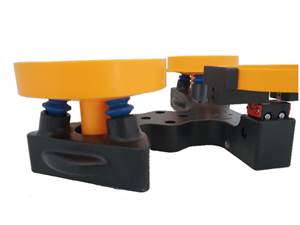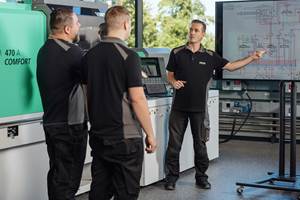Family-Owned Thermoformer Continues to Flourish
By adding technology, home-grown tooling, and automation, industrial thermoformer C&K Plastics has grown while getting its costs under control.
Attention to detail, cost control, diversification, and automation have combined over the last 50+ years to bring success to custom thermoformer . This year, the company expects to generate $14 million in sales, twice what it recorded just two years ago. While part of that can be attributed to C+K’s recent purchase of Speck Plastics Inc., Nazareth, Pa., most of it can be explained by organic growth.
“Business is up by about 40% from last year before taking into account the Speck acquisition in April,” remarks Bob Carrier, C+K president and owner. Speck was not only a “friendly competitor,” Carrier adds, but had a connection to C+K that went back to the early 1960s.
As Bob Carrier explains it, his father, the late Emile Carrier, was trained in thermoforming by Walter Speck Jr. after leaving General Tire, where he sold sheet. In 1962, Emile Carrier joined with another former General Tire employee, Dan Koch, to start C+K in Linden, N.J., a stone’s throw from Newark Liberty International Airport. “The reality is that my dad was trained by a man who would become a competitor, yet it was always friendly,” says Bob Carrier.
Speck Plastics became available for purchase because Walter Speck III wanted to pursue interests beyond thermoforming. His sister, Suzann Speck, has joined C+K as part of its Mid-Atlantic sales team.
C+K was originally financed by a $3000 loan from the Koch family, so the elder Carrier and Koch built a lot of their own equipment and started forming camera cases and a variety of other “oddball parts,” says Bob Carrier. “There was very little in the way a technology,” he recalls. “A lot of work was done by hand, which wasn’t all that unusual back then.”
Bob Carrier got into the ┤¾¤¾┤½├¢ in 1986, bought out Dan Koch, and operated out of a 10,000 ft² plant in Roselle Park, N.J. In 1997, Carrier moved C+K to its current location in Metuchen, N.J., which at the time was 40,000 ft². His timing on the move could have been a bit better, he admits. “On moving day, a snow storm dumped about 2 ft of powder on New Jersey,” Carrier recalls. “The only way I was able to get out was by following the tractor trailers and moving vans that were able to cut a path through the snow.”
Emile Carrier retired in 1991, “and slowly but surely” his son began to modernize the operation. Today, C+K is an ISO 9001:2008-certified thermoformer that operates out of an 80,000 ft² plant, employs more than 70, and runs two shifts five days a week. It supplies parts to a wide range of industries. Its products are used in items ranging from golf and utility carts, ATM and vending-machine covers, column covers for gas pumps, treadmills, refrigeration components (such as the ice bin depicted on the cover), and domes that used to protect electronic components on yachts.
Diversity became necessary around 2001, when one of C+K’s largest customers went out of ┤¾¤¾┤½├¢, and several others moved their operations to China and began sourcing parts there. While a lot of that ┤¾¤¾┤½├¢ has returned, Carrier made the strategic decision to examine other markets. Around that time, he also took over full ownership of Valley Extrusions, a custom-profile and tubing processor in a 200,000 ft² plant in Allentown, Pa.
MODERN OPERATIONS
C+K today runs four rotary and two single-station formers. Its manufacturing capabilities include vacuum, pressure, and twin-sheet forming. Its newest machine is a three-station machine from ., Carol Stream, Ill. C+K also offers a wide range of secondary services, including tight-tolerance, five-axis CNC trimming, robotic trimming, bar coding, die cutting, hot stamping, silk screening, and assembly, including riveting and solvent bonding.
The firm used to outsource painting, but two years ago when its supplier decided that it no longer wanted to paint plastics—giving C+K two weeks’ notice of its decision—the thermoformer acted quickly and installed its own paint room, mostly to give its dome covers the high-gloss finish that boat owners typically demand. “It’s not surprising that people who own multi-million-dollar yachts are extremely particular about how their dome covers look,” Carrier comments. “Some, in fact, actually buy two covers when they only need one. That’s strictly for appearance too; they put domes on each end of the yacht to give it balance.”
C+K works primarily with cut sheet from one to five layers and up to ½ in. thick, furnished by firms such as ., Richmond, Ind., , Holland, Mich., , Aurora, Ill., and , Bloomsburg, Pa. C+K forms sheet from a wide range of materials, notably acrylic-capped ABS, acrylic, PVC, all kinds of PEs, PC, TPO, and PETG. “We will soon be forming sheet up to 1 in. thick because of some new applications,” Carrier states. C+K can form a sheet up to 96 x 144 in.
The firm also designs and builds all of its own tools from aluminum, as well as its plugs. These capabilities allow it to provide preproduction samples off CAD patterns supplied by customer, letting clients do preliminary evaluations of samples before C+K mills production tooling.
C+K uses Vantage ERP (enterprise resource planning) software from , Austin, Texas, to track the entire cycle of ordered parts. “The software allows us to track orders and know precisely what our costs are along the way,” Carrier explains. “We start by entering a quote, which creates a router and a bill of materials. From there, software “buckets” get filled with our cost of labor, materials, assembly, and whatever else is required to make the part.”
Carrier adds, “(EPR) has been vital to help us understand our ┤¾¤¾┤½├¢. It’s particularly helpful when projects have to be conducted on a just-in-time basis.” Carrier says the system allows C+K to evaluate employee utilization, efficiency, scrap rate, and other factors by customer and by part.
GOING GREEN
In 2011, C+K began to focus more on energy efficiency. It put on a new roof and installed a 500-kW solar system that supplies about 40-50% of the company’s power, saving it $100,000/yr. Carrier also put in more efficient lighting at both C+K and Valley Extrusion plants, to the tune of 1600 fixtures, 2000 light bulbs, and 400 motion sensors.
Carrier said C+K paid $30,000 cash and borrowed more than $200,000 to help finance the project. It also received a $660,000 federal grant, and a $1.3 million loan from its local utility. “The new energy system,” Carrier notes, “has outperformed expectations.”
Related Content
Ensuring Repeatability: The Key to Effective Injection Molding Automation
One of automation’s key promises is repeatability: the same movement to the same location, time and time again. But to achieve that, all elements involved — robot, machine, EOAT, mold — must be in and stay in alignment.
Read MoreAI: The Next Big Thing in Plastics Processing
Discover how artifical intelligence is revolutionizing plastics processing. Hear from industry experts on the future impact of AI on your operations and envision a fully interconnected plant.
Read MoreFive Ways to Increase Productivity for Injection Molders
Faster setups, automation tools and proper training and support can go a long way.
Read MoreBoston Dynamics Stretches Into Autonomous Warehouse Robotics
The robotics company’s second commercial product is designed to take on physically challenging warehouse tasks.
Read MoreRead Next
See Recyclers Close the Loop on Trade Show Production Scrap at NPE2024
A collaboration between show organizer PLASTICS, recycler CPR and size reduction experts WEIMA and Conair recovered and recycled all production scrap at NPE2024.
Read MoreMaking the Circular Economy a Reality
Driven by brand owner demands and new worldwide legislation, the entire supply chain is working toward the shift to circularity, with some evidence the circular economy has already begun.
Read MoreBeyond Prototypes: 8 Ways the Plastics Industry Is Using 3D Printing
Plastics processors are finding applications for 3D printing around the plant and across the supply chain. Here are 8 examples to look for at NPE2024.
Read More













